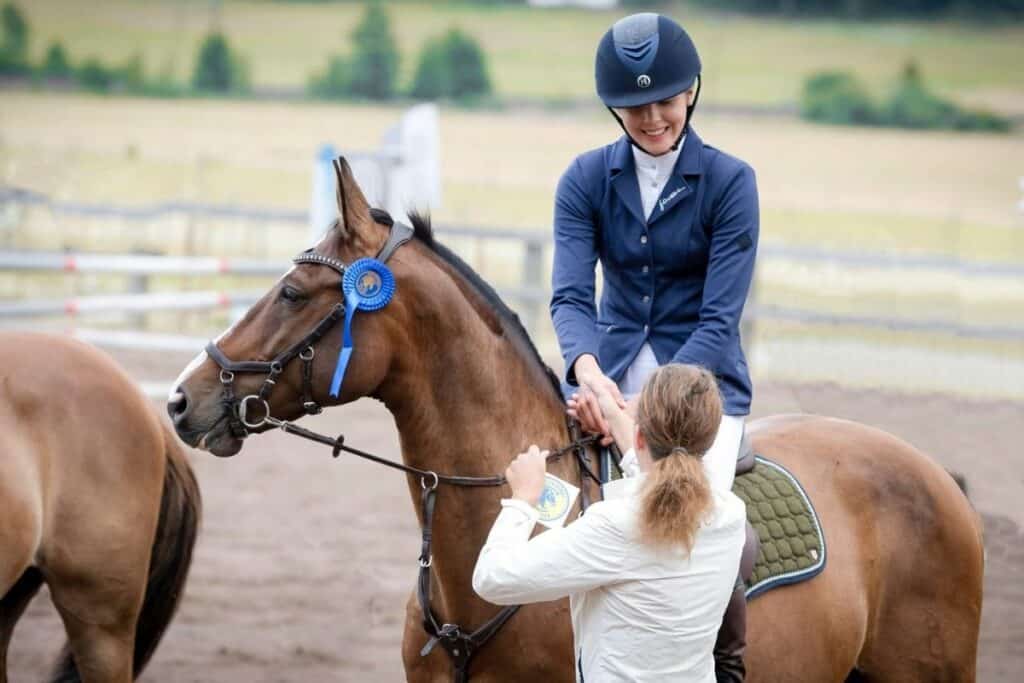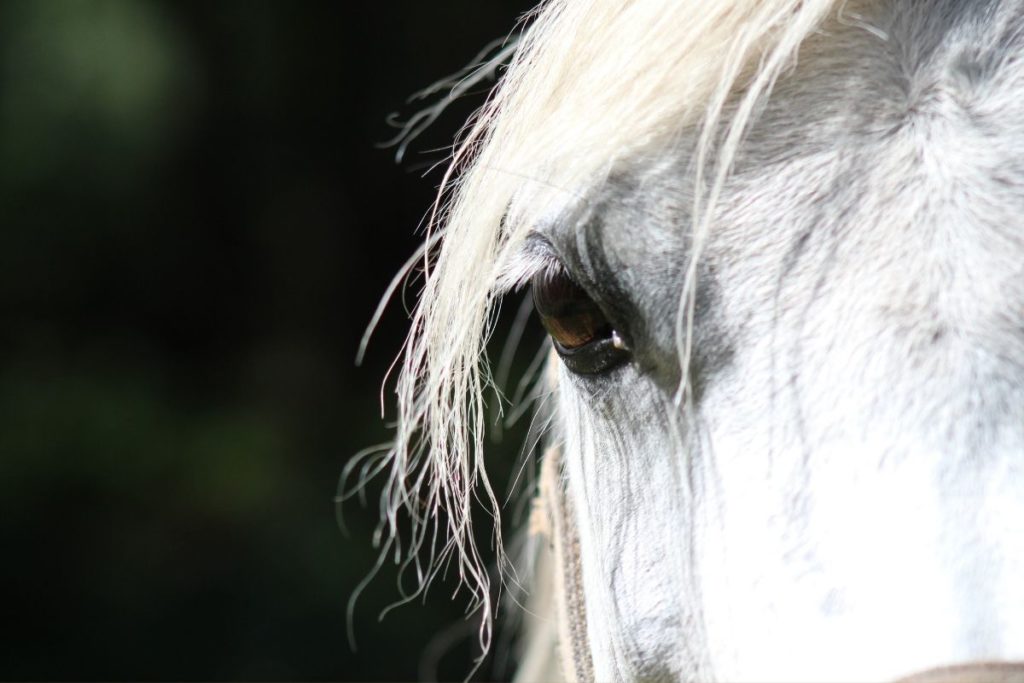It can be tricky to know what is good for a horse with arthritis when it comes to jumping or other exercises. We never want to see them in pain or push them too hard. But we also don’t want to take away an activity that they love, and that keeps them active and healthy.
When you consider if a horse with arthritis can still jump, it will depend on the severity of arthritis, overall health, and figuring out if the exercise is helping or hurting. Horses can still jump with arthritis. But learning more about their condition first will help you understand just how much jumping they can handle.
Because arthritis is an inflammation of the joint, the pounding element of landing a jump can cause arthritis flair-ups. But the health benefits horses receive from daily outings are also instrumental.
At What Age Do Horses Get Arthritis?
The age that horses start to get arthritis can vary widely based on the horse breed and their daily activity levels and uses. Like humans, there are plenty of risk factors that can affect the age that a horse may or may not get arthritis.
Many horses will begin seeing symptoms of arthritis around 15 years old. This is due to a metabolic shift, according to Equisearch. This shift causes faster cell death in their bones, fibrous tissue, and cartilage. Around that age, and for a few years after, they also lose some elasticity in their ligaments and tendons.
While cartilage thins and bones lose some of the density, it can easily lead to arthritis from the constant pounding that is no longer being cushioned as well.
There are still plenty of horses who get arthritis much younger. So, don’t be alarmed if your horse begins experiencing arthritis even as young as 4 or 5 years old. Many horses will see early-onset osteoarthritis around this age, especially if they are used to excessive jumping or labor.

How Conformation Can Affect When Your Horse Gets Arthritis
Your horse’s structural deviations can have different impacts and implications on when they may experience the early signs of arthritis. With better confirmation comes a better chance that they won’t get arthritis or get it very late in life. It could also mean they just have a minor form of it.
Whereas, if your horse has a poor conformation, this could mean they will get arthritis earlier or will, unfortunately, have worse symptoms, which would further affect their ability to jump.
Even standing can cause minor joint degeneration in horses due to their size. Their conformation is so important because it will either help delay those deteriorations or escalate them.
Horses with Arthritis Continuing to Jump
Horses can continue jumping if they have arthritis. But you will want to consider their age, severity of arthritis, and how they are reacting to jumps. If they seem to be in pain or have trouble clearing a small jump, you will want to ease up. Continue getting them daily exercise but keep it less stressful on their joints.
If they seem to be having an easy enough time with jumps, continue letting them do them, but monitor and make sure you are listening to your vet with treatment plans and anti-inflammatory measures.
How High Can Horses with Arthritis Jump?
This question will best be answered by your vet. Most likely, smaller jumps will be all your arthritic horse should try to conquer. But you will need to understand the severity of arthritis before being able to determine just how high those little jumps can be.
It will also depend on the conformation of the horse, their weight, age, and other factors that your vet will want to advise on before deciding to let them continue jumping.
But plan for smaller, easier jumps than they were once used to.
Exercise and Arthritis
Exercise is key for horses of any age or condition. But a horse with arthritis will greatly benefit from additional exercise. Regular walks on easy trails, riding, and small jumps will help their circulation and muscles stay in strong shape.
The increased circulation helps to promote healing, and a continued routine of smaller jumps or exercise will help build stronger muscles to help keep their bone structure in line.
And above all, the exercise will be most helpful in keeping extra pounds off. If your horse has arthritis, the last thing they need is to put on unnecessary weight.
What Are Signs of Arthritis in a Horse?

Understanding the signs of arthritis will help keep the symptoms at bay for longer and can even lead to early prevention, which we will talk about a bit more later in this article.
According to VCA Hospitals, joint inflammation increases fluid in the joint when arthritis is present. This will typically cause a bulging in the joint capsule. But keep in mind, that is not a definite sign that it is arthritis. There are other reasons the joint could swell, which could be as simple as a strain.
When the swollen joint is also causing pain when bent, that is typically a good indicator that the horse is suffering from arthritis. In cases of acute arthritis, the joint may also feel warm to the touch.
You will also notice a limited range of motion in many cases. There is surface damage caused by the bone due to the thinning cartilage. New bone will form over the area, and it won’t be protected by cartilage anymore.
The absence of a protective layer can cause a range of motion to be slightly limited. So, you will most likely notice discomfort from the horse during certain movements, but you will also see a smaller range of motion.
With that range of motion is limited, you may also notice stiffness. And with older horses, you may see them having issues standing for long periods, as well as having a hard time standing up after sitting for a long time.
When you see these symptoms, you can still allow the horse to jump but only if it seems to not be causing too much pain. Listening to what your horse is telling you through their body language and actions will help you determine if they should still be jumping or not.
Should You Buy a Horse with Arthritis?
When it comes to buying a horse with arthritis, you should ask yourself why you are getting that horse. If you are hoping to have them for jumping or labor, you will want to consider how advanced or severe their arthritis is. While they can still do these things with arthritis, it can be more difficult, and they may not be able to do it for as long.
At the end of the day, horses can still do a lot with arthritis, and they would love and appreciate a good home. Even if they are dealing with some pain or stiffness from arthritis, they will still appreciate the exercise and will be able to complete many tasks.
If you want to have a horse to ride occasionally and not do anything too strenuous, you can still buy a horse with arthritis.
Keep in mind their age. If it is an older horse with arthritis, you shouldn’t expect vigorous jumping or exercise from them. But if they are younger and have a more mild arthritis case, you can still expect to get some good years of jumps as long as they are easier jumps, and you aren’t pushing them too long or too hard.
How Do You Prevent Arthritis in Horses?
Through healthy exercise, avoiding repetitive pounding on their joints for long periods, and supplements, and a healthy diet, you can help prevent arthritis in your horse.
According to The Horse, a study done at Texas A&M University suggests that prevention is very doable if you are paying attention and being very deliberate in your decisions for your horse.
When exercising your horse, make sure you don’t push them too long or too hard. Exercise will help them prevent things like weight gain, causing additional pressure on the joints, leading to arthritis. So it’s important to keep them active, but always consider the wear and tear you are inflicting on their joints during a certain exercise.
Any anti-inflammatory supplements or treatments will help minimize swelling and help keep their joints in health condition, which will help to prevent the possibility of arthritis.
Arthritis and Jumping
Your horse should still be able to jump if they have arthritis. But you want to speak with your vet and have a full picture of their arthritis stage and understand their specific situation.
Your horse will need to do smaller, easier jumps with arthritis, but that will be perfectly fine for most horses. Jumping will help them keep off weight, invigorate circulation, and build strong muscles, which all help a horse with arthritis as well.
